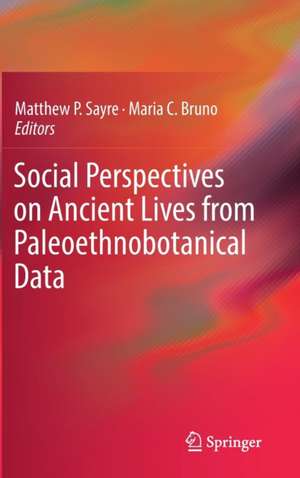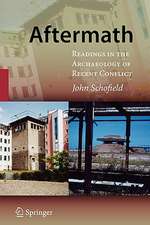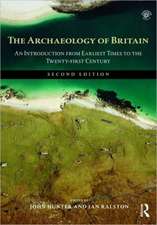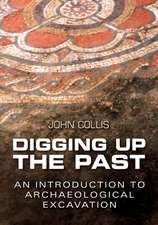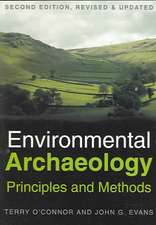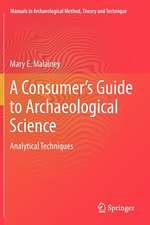Social Perspectives on Ancient Lives from Paleoethnobotanical Data
Editat de Matthew P. Sayre, Maria C. Brunoen Limba Engleză Hardback – 27 mar 2017
The authors in this volume address several themes including: the collection of wild resources, the domestication of crops and spread of agriculture, the role of plant remains in questions regarding domestic life, ritual, and gender as well as the broader implications of a socially-engaged paleoethnobotany. These studies point a path forward for the constantly evolving field of paleoethnobotany, one that is methodologically rigorous and theoretically engaged. Together, these papers shed light on ways in which the specialized analysis of plant remains can contribute to theory building and advancing archaeological understanding of past lifeways.
| Toate formatele și edițiile | Preț | Express |
|---|---|---|
| Paperback (1) | 635.31 lei 6-8 săpt. | |
| Springer International Publishing – 19 iul 2018 | 635.31 lei 6-8 săpt. | |
| Hardback (1) | 641.53 lei 6-8 săpt. | |
| Springer International Publishing – 27 mar 2017 | 641.53 lei 6-8 săpt. |
Preț: 641.53 lei
Preț vechi: 754.74 lei
-15% Nou
Puncte Express: 962
Preț estimativ în valută:
122.80€ • 133.43$ • 103.21£
122.80€ • 133.43$ • 103.21£
Carte tipărită la comandă
Livrare economică 21 aprilie-05 mai
Preluare comenzi: 021 569.72.76
Specificații
ISBN-13: 9783319528472
ISBN-10: 3319528475
Pagini: 206
Ilustrații: X, 180 p. 29 illus., 22 illus. in color.
Dimensiuni: 155 x 235 x 13 mm
Greutate: 0.45 kg
Ediția:1st ed. 2017
Editura: Springer International Publishing
Colecția Springer
Locul publicării:Cham, Switzerland
ISBN-10: 3319528475
Pagini: 206
Ilustrații: X, 180 p. 29 illus., 22 illus. in color.
Dimensiuni: 155 x 235 x 13 mm
Greutate: 0.45 kg
Ediția:1st ed. 2017
Editura: Springer International Publishing
Colecția Springer
Locul publicării:Cham, Switzerland
Cuprins
Chapter 1. Social Paleoethnobotany: New contributions to Archaeological Theory and Practice (Maria Bruno and Matthew Sayre).- Chapter 2. Integrating archaeological data toward a better understanding of food plant choices and territory exploitation in the Northwestern European Early Neolithic: The case of Remicourt “En Bia Flo II” (Alexandre Chevalier and Dominique Bosquet).- Chapter 3. Cultigen Chenopods in the Americas: A Hemispherical Perspective (Gayle J. Fritz, Maria C. Bruno, BrieAnna S. Langlie, Bruce D. Smith, and Logan Kistler).- Chapter 4. Rethinking the Role of Wild Resources in Agriculturalist Societies: Archives from Rockshelter Cases of Northwestern Argentina (M. Alejandra Korstanje).- Chapter 5. Exploring Culinary Practices through GIS Modeling at Joya de Cerén, El Salvador (Alan Farahani, Katherine L. Chiou, Rob Q. Cuthrell, Anna Harkey, Shanti Morell-Hart, Christine A. Hastorf, and Payson D. Sheets).- Chapter 6 .Plant Use andthe Separation of Ritual and Domestic Space at Conchopata, Peru: A Middle Horizon Site (William Whitehead and Matthew Sayre).- Chapter 7. Ritual Time: The Struggle to Pinpoint the Temporality of Ritual Practice using Archaeobotanical Data (Christopher T. Morehart).- Chapter 8. A Compelling Intersectionality: Paleoethnobotany, Social Theory and Feminist Commitments (Margaret Conkey).- Chapter 9. Paleoethnobotany beyond Diet, Environment, and Ecology (Deborah Pearsall).
Notă biografică
Dr. Matthew P. Sayre is currently an Assistant Professor at the University of South Dakota. He teaches courses in Archaeology, Biological Anthropology, and Historical Ecology. He is also active in the development and teaching of the new Sustainability Major. His research focuses on the past ecology, ritual, and production practices of people in the Andean region of South America. He has worked at the UNESCO World Heritage site of Chavin de Huantar, Peru over the last decade and leads a field project focused on the domestic settlements in the La Banda sector of the site.
Dr. Maria C. Bruno is currently an Assistant Professor at Dickinson College where she teaches courses in Archaeology and World Prehistory, Environmental Archaeology, and Archaeological Method and Theory. She is also actively engaged in Dickinson College’s interdisciplinary Center for Sustainability Education. Her research focuses on the environmental, technological, social, and political dynamics of ancient agricultural systems in South America, particularly in the Lake Titicaca Basin of the Andes and in the Llanos de Moxos region of the Amazon Basin.
Textul de pe ultima copertă
This volume contributes to the emerging topic of social paleoethnobotany with a series of papers exploring dynamic aspects of past social life, particularly the day-to-day practices and politics of procuring, preparing, and consuming plants. The contributors to this volume illustrate how one can bridge differences between the natural and social sciences through the more socially-focused interpretations of botanical datasets. The chapters in this volume draw on a diversity of plant-derived datasets, macrobotanical, microbotanical, and molecular, which contribute to general paleoethnobotanical practice today. They also carefully consider the contexts in which the plant remains were recovered. These studies illustrate that the richest interpretations come from projects that are able to consider the widest range of data types, particularly as they aim to move beyond simple descriptionsof food items and environmental settings.
The authors in this volume address several themes including: the collection of wild resources, the domestication of crops and spread of agriculture, the role of plant remains in questions regarding domestic life, ritual, and gender as well as the broader implications of a socially-engaged paleoethnobotany. These studies point a path forward for the constantly evolving field of paleoethnobotany, one that is methodologically rigorous and theoretically engaged. Together, these papers shed light on ways in which the specialized analysis of plant remains can contribute to theory building and advancing archaeological understanding of past lifeways.
The authors in this volume address several themes including: the collection of wild resources, the domestication of crops and spread of agriculture, the role of plant remains in questions regarding domestic life, ritual, and gender as well as the broader implications of a socially-engaged paleoethnobotany. These studies point a path forward for the constantly evolving field of paleoethnobotany, one that is methodologically rigorous and theoretically engaged. Together, these papers shed light on ways in which the specialized analysis of plant remains can contribute to theory building and advancing archaeological understanding of past lifeways.
Caracteristici
Discusses a range of current theoretical approaches in environmental archaeology Analyzes botanical, zoological and geological data through an archaeological context Considers diverse case studies varying across space and time Includes supplementary material: sn.pub/extras
